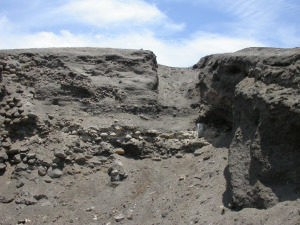
A new study published in Science Advances reports the earliest known use of indigo dye, discovered in an unusually well-preserved, 6,000-year-old Andean cotton fabric from Peru, which retained traces of the blue pigment. The finding predates the earliest reported use of indigo, in ancient Egyptian textiles, by about 1,500 years. When Spaniards arrived in the Americas, they were impressed by Andean weaving and dyeing practices. To date, evidence of the age and complexity of these practices has largely come from cotton textiles found in Huaca Prieta, a large ceremonial mound in Peru first excavated in the 1940s. Previous research suggests that the earliest cotton textiles from this site to feature blue pigment are roughly 6,000 years old, though the source of the blue color on these fabrics has been unknown. Using high-performance liquid chromatography and photodiode-array detection, researchers lead by Jan Wouters, Ana Claro, and Jeffery Splitstoser analyzed a sample of blue yarn from one of the ancient blue-striped fabrics, along with samples of blue yarns from seven other fabrics from the Huaca Prieta. The authors found that the blue in the ancient cotton textiles came from plant-based indigoid dye (indigotin). The results indicate that humans were using indigo to dye textiles as far back as 6,000 years ago, much earlier than ancient Egyptians, who were dying textiles with indigo 4,400 years ago. Other early examples of indigo dye use are known from artifacts in China, where indigo has been positively identified as early as 3,000 years old. It is believed that indigo might have been used earlier in the Near East; however, actual examples with positive identifications of the blue dye are not available, making the indigo found at Huaca Prieta the earliest known and document use of indigo.
___________________________________
Cut made during excavations by Junius Bird in the 1940’s that revealing several floor layers and other architecture. Credit: Jeffrey C. Splitstoser
______________________________________________
Indigo-blue and natural-white striped cotton fabric made of regular spaced weft twining from Phase 3 contexts, ca. 5848–5585 BP. Credit: Lauren A. Badams
______________________________________________
Source: Press release of Science Advances. Science Advances is published by AAAS, the nonprofit science society.
___________________________________

______________________________________________
Travel and learn with Far Horizons.
____________________________________________
This richly illustrated issue includes the following stories: Recent findings shedding new light on the whereabouts of the remains of Philip of Macedon, father of Alexander the Great; how an archaeologist-sculptor is bringing bones of the dead back to life; archaeologists uncovering town life at the dawn of civilization; an exclusive interview with internationally acclaimed archaeologist James M. Adovasio about what makes the Meadowcroft Rockshelter prominent in the ongoing search for the first Americans; what archaeologists are finding at the site of the ancient city of Gath, the home town of the biblical Philistine giant, Goliath; and how scientists are redrawing the picture of human evolution in Europe. Find it on Amazon.com.









